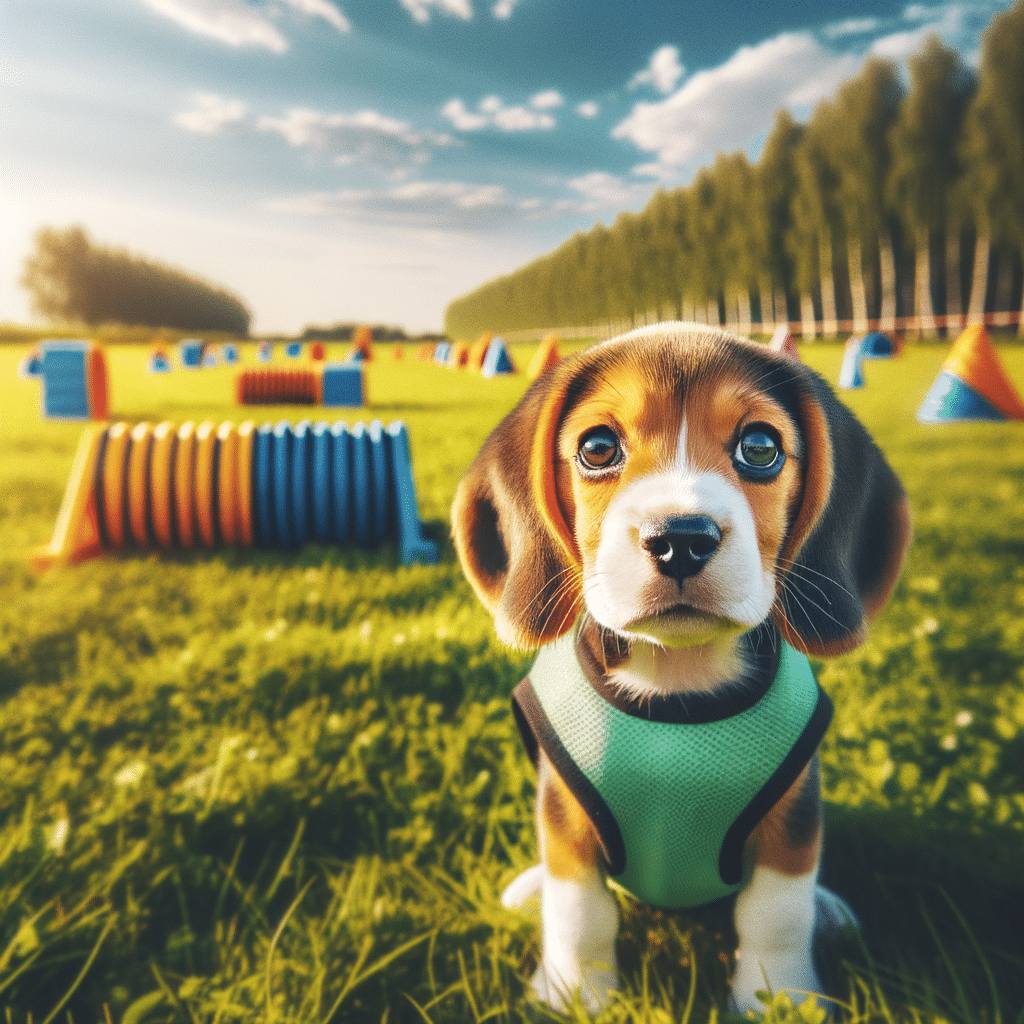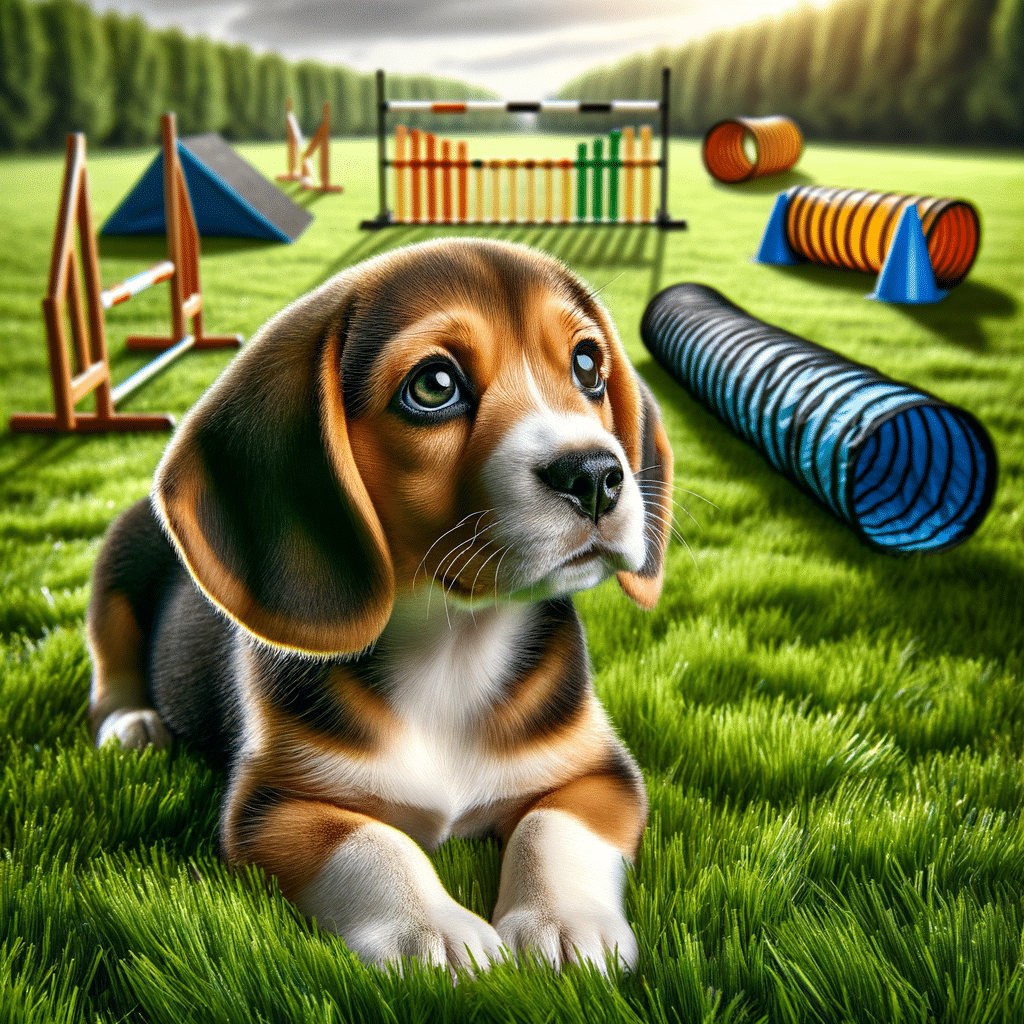Training a beagle puppy can be a rewarding experience that creates a strong bond between you and your pet. Beagles are known for their friendly nature, keen sense of smell, and energetic personality.
In This Article
Given their history as scent hounds, they naturally desire to follow their noses, which can sometimes lead them off-track if not properly guided. Learning the proper beagle puppy training techniques will help you turn their natural urges into positive behaviors.
Establishing good habits from the start is essential in beagle puppy training. House training should be one of the first training sessions, and it’s ideal to start as soon as your beagle pup is old enough to go outdoors.
Socialization is equally important. This means introducing them to various environments, people, and other dogs to develop well-adjusted behavior. Teaching fundamental commands such as sit, stay, and come helps manage your pup’s independent streak and ensures their safety in potentially dangerous situations.
Highlights
- Early training and socialization are vital for beagle puppies.
- Basic commands are essential for good behavior and safety.
- Consistency and patience are key to Beagle training success.
Understanding Your Beagle Puppy
Training a beagle pup requires understanding its unique traits and developmental phases. With this knowledge, you can create a conducive training environment that caters to your dog’s nature.
Beagle Characteristics
Beagles are energetic and curious dogs, well-known for their keen scent-tracking abilities. They have a strong history of working with humans, especially in environments that require scent detection.
This breed tends to be independent and somewhat stubborn, which can pose challenges during training sessions. Understanding this dog breed’s need for socialization with other dogs and people can help bring out its friendly nature.
Beagle Puppy Development Stages
- Early weeks (0-8 weeks): At this stage, beagle puppies are developing their senses and movement abilities. Socialization with their siblings and their mother teaches them basic behavioral cues.
- Socialization period (8-12 weeks): In this important early development stage, introducing your beagle puppy to various people, other dog owners, and different environments can help create positive experiences that benefit your pup’s personality.
- Teething and ranking period (3-6 months): Puppies go through teething, which may lead to nipping or chewing. Consistent training helps establish leadership and prevent unwanted behaviors.
- Adolescence (6-18 months): Beagle puppies may show more independent behavior and try to test boundaries. Positive reinforcement techniques help maintain discipline during this time.
Understanding these characteristics and growth stages can improve the training process and create a nice bond between you and your pup.
Basic Training Techniques
Training a beagle puppy requires a clear structure and consistent reinforcement. Successful training depends on establishing authority and using positive reinforcement techniques.
Establishing Leadership
Dog owners need to establish themselves as leaders to train beagles effectively. Basic commands such as sit, stay, come, and heel are important in creating the foundation for this leader-follower relationship. Leadership tips include:
- Consistency: Use the same command for each action every time.
- Self-control: Beagles respond to calm and assertive energy, so maintain self-control during the training session, even when frustrated.
- Repetition: Reinforce commands with firm but kind guidance to prevent confusion.
Positive Reinforcement
Using positive reinforcement techniques can improve the beagle’s learning process. This method involves rewarding your puppy with treats or praise immediately after they follow a command correctly. Here are specific training methods to apply positive reinforcement:
- Always reward good behavior immediately to show the puppy the connection between action and command.
- Balance food rewards and praise to avoid relying too much on treats.
- As the puppy learns, the complexity of basic commands increases, reinforcing each step with a reward.
Teaching Fundamental Commands
Training a beagle puppy requires a structured approach using clear, consistent commands. This ensures the puppy understands what is expected and helps develop good behaviors. By focusing on the ‘Sit,’ Stay,’ and ‘Recall’ commands, along with crate training, you can lay a strong foundation for your dog’s obedience.
The Sit Command
To teach the sit command, start by gaining the puppy’s attention. With a treat in hand, move the treat above the beagle’s nose, encouraging the puppy to look up and naturally sit down. Once seated, say “Sit” firmly and give the treat as a reward.
- Steps to teach the sit command:
- Hold a treat close to the puppy's nose.
- Move the treat upward, over the head.
- As the puppy sits, say “Sit.”
- Reward with the treat and praise.
The Stay and Recall Commands
For the “Stay” command, start with the puppy in the sit position. Use the “Stay” command with an outstretched hand, step back, and quickly reward the puppy with praise or a treat if the puppy maintains the position.
The recall command teaches the beagle to come when you call it. These commands are important for your pup’s safety and behavior management. Starting on a leash, use a consistent command, like the puppy’s name, followed by “Come!” When the puppy responds, reward them with a treat and praise.
Practice each command regularly and keep each training session short to keep your dog’s attention. Be confident and consistent to ensure successful training.
Crate Training
Crate training is essential for giving your puppy a personal space. It also helps with housebreaking. Your dog should associate the crate with positive experiences. So feed the puppy in the crate and leave treats inside to help them adapt to the crate environment.
Tips for effective crate training include:
- Ensure the crate is comfortable and not used as punishment.
- Introduce the crate gradually, using treats and meals.
- Establish a routine to help with the training program.
Establishing Good Habits
Training a beagle puppy requires patience and consistency. The foundation of good behavior lies in early and consistent house training, along with managing teething and chewing.
House Training Your Puppy
Start house training as soon as your puppy arrives at its new home. A consistent schedule helps with successful house training. This includes:
- Potty breaks: Take your puppy outside after meals, when they wake up, and before bedtime.
- Consistent location: Choose a specific spot where the puppy relieves itself.
- Positive reinforcement: Reward your pup with praise or treats immediately after they go potty in the right place.
House training also helps the pup learn boundaries within the home. Your beagle should understand where it can go and where it cannot, which helps prevent unwanted behavior.
Coping with Teething and Chewing
Beagles experience teething when young, leading to an urge to chew. You can provide the following items to redirect inappropriate chewing:
- Teething toys: Offer a variety of chew toys to soothe their gums.
- Supervision: Monitor your puppy to prevent them from chewing on unwanted items.
- Exercise: Adequate daily exercise can reduce the urge to chew out of boredom.
Learning the difference between normal teething behavior and potential behavior problems is essential. If a beagle puppy chews excessively, it might need more socializing, attention, or exercise.
Frequently Asked Questions
This section answers common questions about beagle puppy training and addresses concerns such as potty training, optimal training age, and managing typical behaviors like barking and biting.
What are effective techniques for potty training a beagle puppy?
Consistent routines and positive reinforcement can help you effectively potty-train your beagle puppy. Take the puppy outside regularly, particularly after meals and naps, and reward successful outdoor pottying with treats or praise.
Is there an optimal age to begin training a beagle for best results?
Start training your pup as early as possible, usually around eight weeks old, when the beagle is most receptive to learning. This is also a critical period for socialization and establishing house rules.
What methods work best to prevent a beagle from biting?
To prevent biting, teach your dog how to control their biting through games and interactions that discourage hard biting. You can also redirect their attention to chew toys to help prevent biting behavior.
How can you effectively teach a beagle to reduce excessive barking?
Reducing excessive barking involves teaching the beagle the ‘quiet’ command and rewarding the dog for silence. Look your beagle in the eyes and firmly say, “Quiet.” Consistency and understanding what triggers the barking can help solve the issue.
What is the recommended approach for disciplining a beagle without using harsh methods?
Use positive reinforcement to discipline your beagle. You can redirect negative behavior using consistent and firm commands to correct unwanted behaviors without causing fear or harm.
How do the temperaments of beagle puppies affect their trainability?
A beagle’s temperament can significantly influence their trainability. They are generally eager to please and quick learners but can also be stubborn. Tailoring your training methods to cater to the dog’s natural curiosity and desire for play can produce better results.






